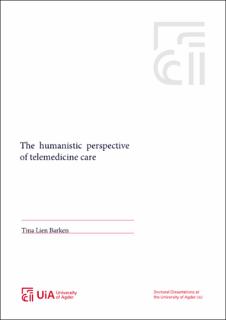| dc.contributor.author | Barken, Tina Lien | |
| dc.date.accessioned | 2024-01-26T07:52:13Z | |
| dc.date.available | 2024-01-26T07:52:13Z | |
| dc.date.created | 2019-10-30T14:31:48Z | |
| dc.date.issued | 2019 | |
| dc.identifier.citation | Barken, T. L. (2019). The humanistic perspective of telemedicine care [Doctoral dissertation]. University of Agder. | en_US |
| dc.identifier.isbn | 978-82-7117-942-7 | |
| dc.identifier.issn | 1504-9272 | |
| dc.identifier.uri | https://hdl.handle.net/11250/3114001 | |
| dc.description.abstract | Background: Chronic obstructive pulmonary disease (COPD) is a serious and progressive disease, entailing chronic, acute and life-threatening illness occurrences with considerable negative impacts on those living with the disease. For patients, nurses and health care systems (HCSs), this disease demands increased care and support in terms of continued, coordinated and routine followup. Telemedicine (TM) has shown to have a positive influence on the COPD care; however, there are still contradictions in its use. As TM plays a great role in the global health care delivery, it will be important to develop a strong knowledge base and to further explore how patients with COPD and nurses experience receiving/providing TM care. Aim: The overall aim of this thesis was to explore and contribute to new knowledge and increase our understanding of the experiences of the patients suffering from COPD and nurses receiving/providing care through TM. Design and methods: Three papers were conducted using several qualitative research methods. In Paper I, ten in-depth interviews were conducted with COPD patients receiving care through TM. The data were analysed using a descriptive phenomenological research method. Paper II used an ethnographic approach, combining different data collection methods, such as participatory observations, the think-aloud (TA) technique and a focus group interview with TM nurses. The collected data were analysed using qualitative manifest and latent content analysis. Papers I and II were carried out according to the framework of a TM intervention. A meta-ethnographic approach was used in Paper III to collect and synthesise the qualitative papers containing the COPD patients’ experiences of receiving care through TM. Twelve papers, published from 2013 to 2018, were included. Findings: The patients with COPD experienced a sense of belonging when receiving care through TM, which was grounded in two fundamental conditions: presence and transparency, providing emotional, social and clinical support. The experience of the TM nurses showed that the fundamental development of ‘knowing the patient’, gained through reasoning and decision-making processes, directly impacted the care and guidance of the patients. Hence, the experiences of the patients with COPD and the TM nurses in the receiving/providing care process of TM were based on the relational connection made possible by the TM ii technology. The TM technology provided a close nurse-patient connection. The human-to-human connection in the TM care was fundamental, whereby the dialogue was necessary to increase the COPD patients’ experience of belonging and for the TM nurses to advance their clinical and personal knowledge, with a view to strengthening the nurse-patient relationship. However, the patients with severe and/or unstable/progressive COPD were found to benefit most from the TM care. Conclusions: The human-to-human connection was identified as an essential element for the patients’ experience of belonging in the TM care and for the TM nurses to acquaint themselves with the patients. Hence, this thesis offers three main conclusions. First, high severity of COPD increased the need for connection and belonging in the TM care. This is an important contribution to the existing, albeit contradictory, evidence base, as it contributes to a renewed understanding of who would benefit from TM and why. Second, the TM technology enabled close yet distant TM encounters, where nurses and patients learnt from each other through dialogue, contributing to the well-being and more-being of the COPD patients and increasing the clinical and personal knowledge of the TM nurses. Finally, a humanistic connection of care was obtained by the dialogical act of nursing through the TM care; hence, the dialogue became the caring act of the TM care. | en_US |
| dc.language.iso | eng | en_US |
| dc.publisher | Universitetet i Agder | en_US |
| dc.relation.ispartofseries | Doctoral dissertations at University of Agder;no. 242 | |
| dc.relation.haspart | Paper I: Barken, T. L., Thygesen, E. & Söderhamn, U. (2017). Unlocking the limitations: Living with chronic obstructive pulmonary disease and receiving care through telemedicine—A phenomenological study. Journal of Clinical Nursing, 27(1-2), 132-142. Accepted version. Full-text is not available in AURA as a separate file. | en_US |
| dc.relation.haspart | Paper II: Barken, T. L., Thygesen, E. & Söderhamn, U. (2017). Advancing beyond the system: telemedicine nurses’ clinical reasoning using a computerised decision support system for patients with COPD – an ethnographic study. BMC Medical Informatics and Decision Making, 17, 1-11. https://doi.org/10.1186/s12911-017-0573-7. Published version. Full-text is available in AURA as a separate file: http://hdl.handle.net/11250/2487447 | en_US |
| dc.relation.haspart | Paper III: Barken, T. L., Söderhamn, U. & Thygesen, E. (2019). A sense of belonging: A meta-ethnography of the experience of patients with chronic obstructive pulmonary disease receiving care through telemedicine. The Journal of Advanced Nursing (JAN), 75(12), 3219-3230. Accepted version. Full-text is not available in AURA as a separate file. | en_US |
| dc.rights | Attribution-NonCommercial-NoDerivatives 4.0 Internasjonal | * |
| dc.rights.uri | http://creativecommons.org/licenses/by-nc-nd/4.0/deed.no | * |
| dc.title | The humanistic perspective of telemedicine care - COPD patient' and nurses' expereiences of receiving/providing telemedicine care | en_US |
| dc.title.alternative | The humanistic perspective of telemedicine care - COPD patient' and nurses' expereiences of receiving/providing telemedicine care | en_US |
| dc.type | Doctoral thesis | en_US |
| dc.description.version | publishedVersion | en_US |
| dc.rights.holder | © 2019 Tina Barken Lien | en_US |
| dc.subject.nsi | VDP::Medisinske Fag: 700::Helsefag: 800 | en_US |
| dc.subject.nsi | VDP::Medisinske Fag: 700::Idrettsmedisinske fag: 850 | en_US |
| dc.source.pagenumber | 196 | en_US |
| dc.identifier.cristin | 1742332 | |
| dc.relation.project | Universitetet i Agder: 586834 | en_US |

